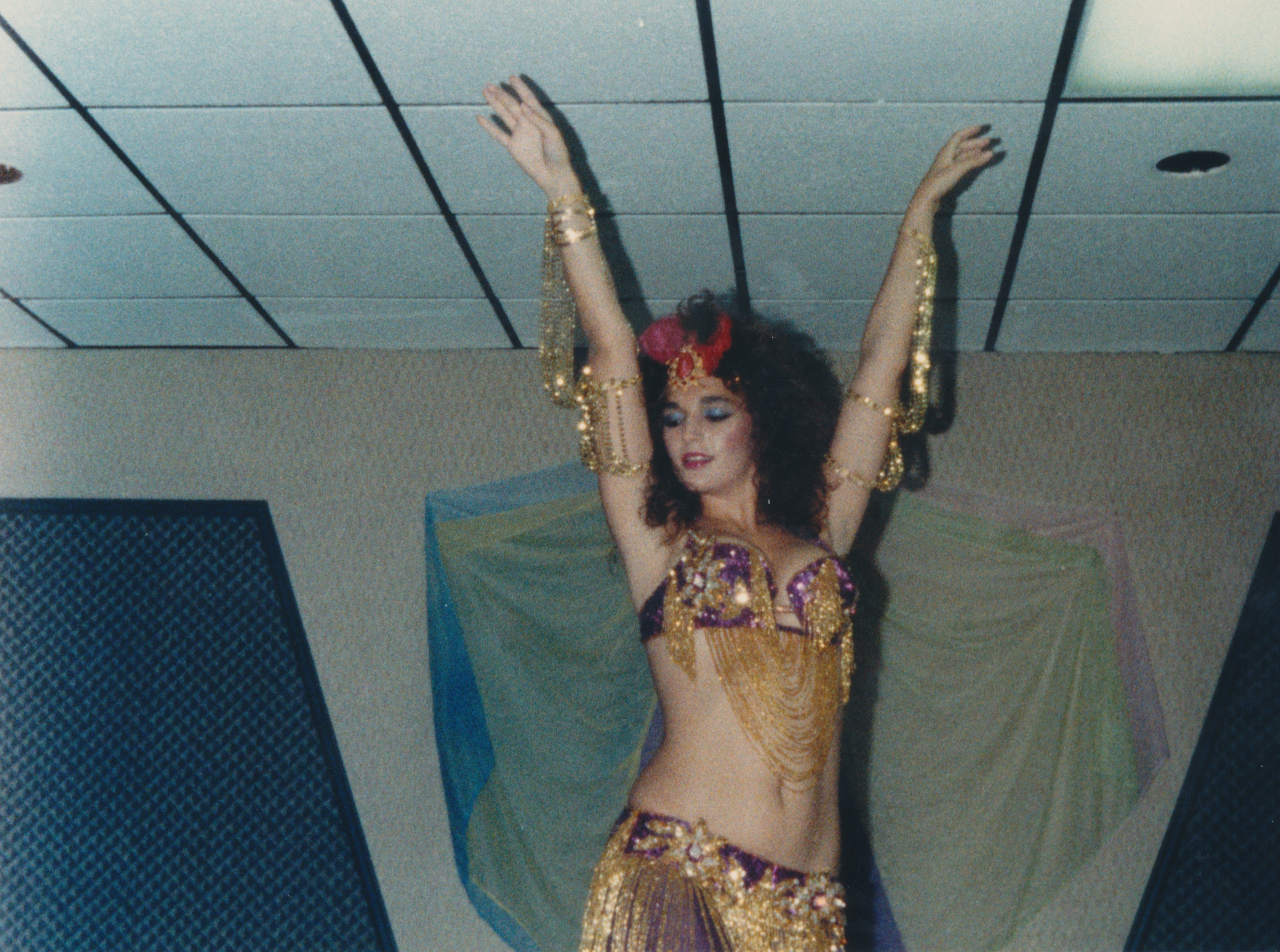What to Watch for in Suhaila Salimpour’s “Banat Iskandaria”
It’s easy to look back at a dance and only see it though a historical lens. We can identify certain movements as “dated” or a body line and position as from a certain time frame in belly dance history. The first dance off of Suhaila Salimpour’s 1988 video Dances for the Sultan, “Banat Iskandaria,” however, arguably still stands the test of time.
Contemporary Relevance
“Banat Iskandaria” straddles a stylistic line. This particular performance highlights one of Suhaila’s first forays into integrating very clear isolations of the rib cage and pelvis into her choreographies. While so-called “locks” and “pops”* of the torso and hips had been performed by dancers in the Middle East (Mona El Said’s full upper body locks come to mind), belly dancers had not so very distinctly made these movements into almost a gestural quality, attempting to separate each part of the body from the other.
Here we also see the beginnings of the layering system that Suhaila developed. Only a few minutes in, she dances Arabic 4 footwork, half-the-timing, with figure 8s front-to-back. This particular combination of movements appears time and time again in her choreographies, often with slight variations in the hips or hand gestures.
Of course, there are some gestures that reveal its era or origin (such as when Suhaila brings her hands to her eyes, pointer finger and middle finger extended, and pulls her hands away from her head symmetrically, a la John Travolta in Saturday Night Fever). And those who know Suhaila’s body of work can see elements that mark this choreography as from a particular period, such as how the hands frame the hips, palms in, when she performs Singles on the Down.
Otherwise, the movements and stylization of this particular piece could appear on many a belly dance stage and still be fresh. In fact, we see many of these elements embraced by the North American belly dance community, both in those dancers who perform more “cabaret” styles and those who perform more “tribal” styles. Turkish belly dance star Didem appears to reference this particular choreography quite a bit in her own performances, as she often integrates quick and direct isolations of the torso into her drum solos.
Innovation within the Belly Dance Genre
We also see clear Jamila Format steps, as always in Suhaila’s work. These are the steps that keep “Banat Iskandaria” firmly within the belly dance genre. Hipwork is always prioritized over tricks, musicality favored over experimentation. In the first taqsim, look for the default Running Choo Choo with Forward-Middle-Middle-Back, while turning counter-clockwise. We also can see variations of the Bounce Step, a default Salaam Step, a lot of Circle Step and variations, Samiha, and Arabic 2 variations.
There is a deliberate quality to all of the movements. Everything has been planned. Notably, also, even the taqsim sequences are choreographed, just as Nadia Gamal set her taqasim when creating her dances.
We see the inspiration of the tribal fusion “micromovements” that are so associated with that stylization in the keyboard taqsim of the baladi progression.
The Euro-American Concert Dance Upper Body Line
In general her upper body is quite upright. What this upright body also shows is the integration of what Suhaila talks about as the “ballet line.” When we watch ballet, we see very similar qualities in the dancers’ upper body. The head is often poised over the ribs and hips, a necessary placement for dancers in pointe shoes or who are often on the balls of the feet. Any deviation from this upright position is deliberate, planned, and controlled. She pivots her head on the top of her neck to the 45° angles learned at the ballet barre. When Suhaila drops into a backbend, it is done in a bound quality, rather than free-flowing. She takes her time to find the edge of the movement, just as a ballerina might take her time to find the edge of her cambre back. Indeed, Suhaila moves her head more than a typical classical ballerina (of course one could watch more contemporary ballet choreographies and see much more movement of the head and rib cage outside the vertical axis of the body). And at the same time Suhaila was integrating her years of classical ballet training into her belly dance performances, belly dancers in the Middle East were also integrating Euro-American concert dance elements into their performances.
Of course, there are the characteristic head releases and head rolls, but they are more contained than Suhaila’s later work. Later choreographies, as seen on Unveiled, and the improvised performances in the Suhaila Solo videorecording show a more free upper body than the one on Dances for the Sultan. The tribal fusion stylization is also marked by a bound neck and head, stacked over the dancer’s center of gravity except for backbends and some floorwork. This comes as no surprise when we learn that Rachel Brice cites this performance as one of her earliest inspirations.
Every time I watch this performance I see more. I see the beginnings of a style that many dancers today don’t even know that they are imitating. When I watch the myriad dancers from North America, I see the legacy of “Banat Iskanderia” in the body line, isolations, and musicality. There are very few performances which hold such a strong place in North American belly dance history. We can pin influences to particular dancers or instructors, but so rarely can we do it for a specific recording. I suspect “Banat Iskandaria” will continue to be relevant to dancers for many years to come.
—
*Belly dancers often use the term “pops and locks” to refer to quick and direct isolations of the torso and pelvis. In street dance, however, Popping and Locking are two distinct forms. Popping, a funk form from the late 1960s and early 1970s, features quick contractions of muscles, mostly in the limbs, but also in the torso. Check out this video from 1986 of Popping pioneer Skeeter Rabbit. Locking, often credited to dancer Don Campbell and his company the Campbellockers in the early 1970s, features quick gestures of the arms and legs, such as pointing. Watch this video of the dance group, The Lockers, on Soul Train in 1970.
Written by: Abigail Keyes (SSBD 5 and JSBD 5 certified instructor)
Link: Banat Iskandaria Set from Dances for the Sultan






